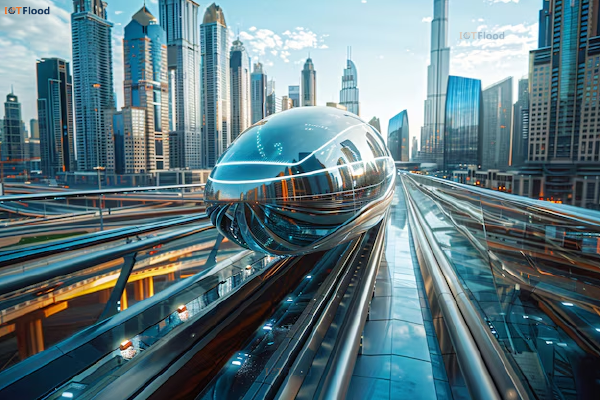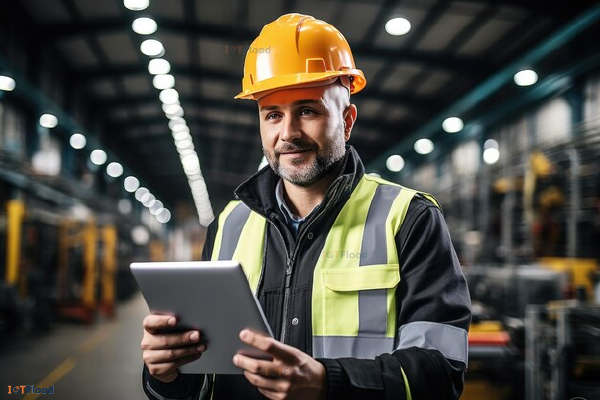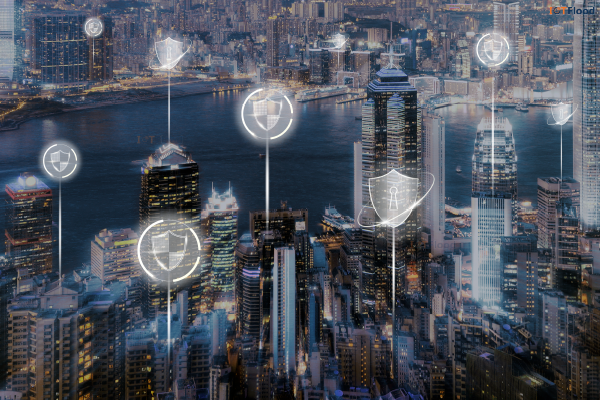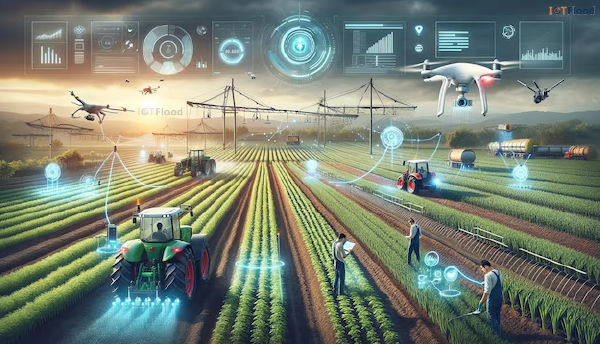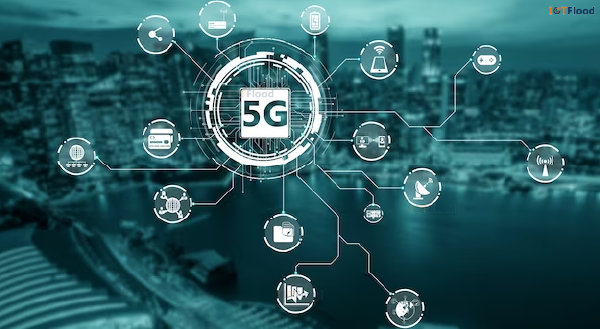5G and IoT – Real-world Applications
The Internet of Things (IoT) and 5G (fifth-generation) wireless technologies are merging to create a revolutionary new wave of innovation and connection. The combination of these two technology giants is pushing IoT devices into a new era of improved communication capabilities, as 5G networks roll out quickly around the globe. This increase in connectivity opens the door for revolutionary developments in many industries by enabling quicker data transmission, more efficiency, and much lower latency. This confluence is radically changing how organisations function and engage with their surroundings, affecting everything from the healthcare industry to manufacturing, transportation, and agriculture.
As 5G networks grow, the IoT landscape is changing dramatically. The real-time data interchange and seamless communication of Internet of Things devices via 5G networks is creating previously unheard-of possibilities for innovation and optimisation. Businesses are using this convergence to improve productivity, simplify procedures, and provide more individualised services. The integration of 5G and IoT is transforming every facet of contemporary life, including autonomous transportation systems, precise farming methods, smart manufacturing facilities, and remote patient monitoring in the healthcare industry.
A new era of connectivity-driven progress is about to begin as we continue to observe the deployment of 5G networks and the expansion of IoT devices. These developments have the potential to yield unprecedented advancements and practical applications.
What is IoT and its Applications?
An autonomous network of linked devices that may share data and communicate with one another over the internet is known as the Internet of Things (IoT). These gadgets can be anything from commonplace items like wearables and smart household appliances to industrial machinery and automobiles that have sensors and connectivity built in. These devices can gather, process, and share data thanks to Internet of Things technology, opening up a plethora of possibilities in a variety of sectors and fields.
Here are a few typical IoT applications:
Smart Home Automation: For convenience, security, and energy efficiency, homeowners can control and automate various home components with IoT devices such as voice assistants, security cameras, lights, and thermostats.
Industrial Internet of Things (IIoT): Industry applications of IoT include supply chain optimisation, asset tracking, predictive maintenance, remote machinery and equipment monitoring, and process automation to boost productivity and cut downtime.
Healthcare: Internet of Things (IoT) gadgets like wearable fitness trackers, remote patient monitoring systems, and sensor-equipped medical equipment assist in tracking health parameters, giving healthcare providers access to real-time patient data, and enhancing patient care.
Smart Cities: To develop more sustainable and effective urban settings, IoT is employed in innovative city efforts for trash management, public safety, traffic control, environmental monitoring, energy management, and infrastructure optimisation.
Retail: To improve the overall shopping experience and operational efficiency, IoT applications in retail include supply chain optimisation, innovative checkout systems, inventory management, customer analytics, and personalised marketing.
Agriculture: To monitor soil conditions, crop health, water usage, and animals, precision farming techniques involving sensors, drones, and automated systems are used in IoT solutions for agriculture. This increases productivity and sustainability.
Transportation and Logistics: Fleet management, cargo safety, route optimisation, vehicle performance monitoring, vehicle tracking, and enhanced logistics operations are all made possible by the Internet of Things.
Energy Management: Smart metres, energy-efficient systems, and demand-response mechanisms are some of the ways that Internet of Things (IoT) devices monitor and control energy use in homes, businesses, and buildings. This helps reduce energy costs and conserve energy.
These uses show how the Internet of Things is having a wide range of effects on several industries, from increasing production and efficiency to improving consumer experiences, safety, and sustainability.
Benefits of IoT
The Internet of Things (IoT) offers enormous advantages that affect many facets of daily life and business. Drawing from the data you submitted, the following is an overview:
Higher Operational Efficiency: The Internet of Things (IoT) saves time and resources by automating functions like data collection and processing. Employees can now concentrate on more creative ideas and efficient data use.
Integration: Better data availability and instantaneous actionable insights are produced by the smooth integration of sensors, devices, and systems made possible by IoT. This integration keeps businesses informed about company events and improves digitisation efforts.
Scalability and Future-Proofing: IoT gives businesses the adaptability to grow their infrastructure and operations in response to new needs and evolving conditions. Businesses may effectively adjust to upcoming technical improvements and market demands because of this scalability.
Cost Reduction: IoT helps reduce operational costs for enterprises by streamlining workflows, automating repetitive tasks, and enhancing resource efficiency.
Better Customer Experience: Data-driven insights and automation made possible by IoT allow for tailored and responsive customer interactions. For instance, by utilising real-time data from linked devices, chatbots powered by the Internet of Things can offer superior customer service.
Data-driven Decision Making: Businesses may make well-informed decisions based on real-time analytics and predictive insights, resulting in better strategic planning and outcomes, thanks to the massive volume of data provided by IoT devices.
Market Growth and Opportunities: Businesses have the chance to innovate, create new goods and services, and broaden their market reach as a result of the expanding IoT market, which boosts overall growth and competitiveness.
These advantages demonstrate how IoT is improving operating capabilities, changing industries, and spurring innovation in a range of fields.
What is 5G, and how does it enhance IoT?
The fifth generation (5G) of cellular network technology offers many advantages over its predecessor (4G), including much faster data transfer speeds, lower latency (the time it takes for data to travel), and the capacity to connect a far greater number of devices. It is an IoT application game-changer. Here’s how:
Unprecedented Speed: Picture a network capable of handling millions of devices concurrently streaming enormous volumes of data. Real-time data sharing is made possible by 5G, opening up applications like autonomous cars and remote surgery where even a few milliseconds of latency might be crucial.
Ultra-Low Latency: In comparison to 4G, 5G reduces latency by a factor of 10. This makes it possible for devices to communicate almost instantly, which is essential for applications like innovative traffic control systems and industrial automation that call for exact timing and coordination.
Massive Device Connectivity: 5G can enable a vast network of interconnected devices, opening the door for the Internet of Things to come to pass truly. A world full of intelligent gadgets that smoothly exchange information is made possible by 5G, from sensor-filled farms to networked cities.
Impact of 5G on Internet of Things(IoT)
The Internet of Things (IoT) and 5G technologies are combining to create a powerful force that is revolutionising innovation and connection. 5 G networks are completely transforming the way that IoT devices interact and communicate because of their incredibly low latency and unmatched speed. More expansive networks of linked devices may be built thanks to this improved connection, opening the door for more effective and efficient IoT solutions across industries.
The capacity of 5G to facilitate real-time data processing and analysis is a significant effect on the Internet of Things. 5G networks’ extremely low latency makes it possible for data to be processed and transferred quickly, enabling Internet of Things (IoT) devices to react quickly to changing circumstances and make snap judgments. Applications where quick data processing is essential for maximum performance, such as industrial automation, remote healthcare monitoring, and autonomous cars, greatly benefit from these capabilities.
Moreover, 5G-powered IoT solutions are driving innovation and transforming industries. From smart cities and connected factories to precision agriculture and healthcare monitoring systems, 5G is unlocking new possibilities and driving the development of groundbreaking IoT applications. By providing enhanced connectivity, real-time data processing, and accelerated innovation, 5G is reshaping industries and driving economic growth in the digital age.
A Glimpse into the Future: Real-World Applications
In addition to being a technological breakthrough, the convergence of 5G and IoT is a catalyst for revolutionary developments in several industries.
Let’s examine more closely how this convergence is shaping the future of real-world applications:
1. Smart Cities: Visualise a city in which all facets of urban life are optimised for sustainability and efficiency:
- Traffic management: Adapting traffic lights dynamically in response to real-time data on traffic congestion can result in less time spent commuting and more efficient traffic flow.
- Waste management: Bins with sensors that alert users when they’re full, maximising collection routes and lessening their adverse effects on the environment.
- Energy Efficiency: Smart grids that minimise costs and encourage energy conservation by balancing energy supply and demand in real time.
2. Industrial Automation: Manufacturing facilities are becoming intelligent hubs where devices can interact with one another and react to changes instantly.
- Predictive Maintenance: By identifying irregularities in equipment before they result in downtime, IoT sensors provide preventive maintenance that saves money.
- Remote monitoring: Enhancing operational efficiency and decreasing manual intervention, this technology allows for real-time monitoring of manufacturing processes and equipment health from any location.
- Optimised Production: Production schedules, inventory control, and resource allocation are all optimised by AI-driven insights from IoT data.
3. Healthcare Revolution: The convergence of 5G and IoT is bringing about a revolution in the healthcare sector that will improve patient outcomes and medical services.
- Remote Patient Monitoring: By transmitting vital signs in real time, wearable gadgets enable medical practitioners to monitor patients’ health from a distance and take immediate action.
- Telemedicine: Remote healthcare delivery is made possible by high-definition video consultations and tests, particularly in remote places or during crises.
- Precision medicine: By tailoring treatment regimens based on unique patient data, real-time data analysis, and AI algorithms, precision and effectiveness are increased.
4. Transforming Transportation: Autonomous, intelligent, and networked vehicles are the norm in the future:
- Self-Driving Cars: To ensure safety and efficiency, autonomous cars depend on real-time data interchange with nearby infrastructure and other vehicles, which is made possible by ultra-low latency 5G networks.
- Intelligent Traffic Management: It includes dynamic routing based on traffic data, predictive analytics for congestion avoidance, and seamless integration of public transportation systems for multimodal commuting.
- Electric Mobility: To encourage the broad use of electric vehicles, IoT-enabled charging stations optimise charging schedules based on grid demand and vehicle usage trends.
5. The Evolving Home: With their increased sophistication and ability to provide convenience, security, and energy efficiency, smart houses are evolving.
- Connected Appliances: Internet of Things (IoT)-capable gadgets talk to one another to provide smooth automation, like modifying temperature control according to occupancy or maximising energy use.
- Intelligent Security Systems: Smart cameras, sensors, and locks that allow real-time surveillance, access control, and automatic danger detection.
- Energy management: Integration with renewable energy sources for sustainable living, automatic lighting and appliance controls, and personalised insights into energy usage.
Convergence of 5G and IoT in Different Sectors
Enhanced Connectivity and Communication
Improving communication networks and connectivity is one of the main benefits of 5G and IoT convergence. 5G’s high-speed, low-latency characteristics enable faster and more efficient data transmission and communication amongst IoT devices than in the past. Increased connectivity is essential for several practical uses, such as:
Smart Cities: Powered by 5 G. Smarter and more sustainable cities are made possible in large part by IoT devices. Real-time data transmission and analysis are beneficial for applications like innovative traffic management, intelligent street lighting, waste management systems, and environmental monitoring because they maximise resource utilisation and enhance citizen experiences.
Healthcare: The confluence of 5G and IoT makes connected medical devices, telemedicine services, and remote patient monitoring possible. Particularly in critical care situations, healthcare practitioners can provide prompt interventions, monitor patients’ vital signs in real time, and enhance overall patient outcomes.
Transportation: To improve convenience, safety, and efficiency, the transportation sector leverages 5G and IoT. Features like fleet management, autonomous driving, real-time traffic updates, and predictive maintenance are made possible by connected cars with IoT sensors and 5G connectivity. These features improve traffic flow and lower accident rates.
Industrial Automation and IoT
Businesses are using 5G-enabled IoT solutions more frequently to improve productivity, stimulate innovation, and streamline processes. Among the necessary applications are:
Manufacturing: Predictive maintenance, asset tracking, inventory management, and real-time production process monitoring are all made possible by smart factories using 5G-enabled IoT devices. As a result, supply chains are optimised, downtime is decreased, and quality control is improved.
Energy and Utilities: Smart grid management, energy monitoring, predictive analytics for equipment maintenance, and renewable energy integration are all made possible by utilities businesses through the use of IoT sensors and 5G networks. These applications result in lower costs, increased sustainability, and more effective use of energy.
Logistics and Warehousing: By enabling real-time cargo monitoring, inventory management, route optimisation, and automated warehouse systems, 5G-powered IoT solutions transform logistics and warehousing operations. This leads to reduced operating expenses, quicker delivery times, and more customer satisfaction.
Immersive Experiences and Entertainment
The combination of 5G and IoT also opens up new avenues for immersive entertainment and experiences, which changes the way we engage with and consume digital material. Among the noteworthy applications are:
Virtual reality (VR) and augmented reality (AR): 5G’s high bandwidth and low latency enable AR and VR apps with smooth, interactive, real-time rendering. AR and VR technologies driven by IoT devices offer immersive and engaging content delivery in a variety of applications, from gaming and entertainment to education and training.
Media Streaming and Content Delivery: Content providers employ IoT devices and 5G networks to stream high-definition video, broadcast events live, and deliver customised content depending on user behaviour and preferences. This promotes innovation in the media sector and improves the user experience overall.
Security and Surveillance
The convergence of 5G and IoT improves public safety and asset protection by fortifying security and surveillance systems. Important uses consist of:
Smart Security Systems: IoT devices that are connected via 5G networks, such as cameras, sensors, and access control systems, allow for automated response mechanisms, facial recognition, anomaly detection, and intelligent security monitoring. This enhances response times in emergency circumstances and situational awareness.
Smart Home Security: 5G-enabled IoT-enabled home security systems provide homeowners with cutting-edge features like video doorbells, smart locks, remote monitoring, and AI-powered security analytics. These solutions give homeowners peace of mind and improve house security.
Environmental Monitoring and Conservation
IoT and 5G are essential for sustainable practices, conservation initiatives, and environmental monitoring. Examples of applications are:
Environmental Sensing: Real-time data on temperature, pollution levels, water levels, air quality, and other parameters is collected via Internet of Things (IoT) sensors placed in natural habitats, urban areas, and water bodies. Environmental monitoring, early warning systems for natural disasters, and decision-making in conservation initiatives are all aided by the analysis of this data.
Precision Agriculture: Farmers use 5G connectivity and IoT devices to monitor crop health, soil conditions, irrigation, and automated machinery, among other precision agriculture activities. Crop yields are maximized, resource waste is decreased, and farming methods are more ecologically friendly as a result.
Advantages of using 5G in IoT
The Internet of Things (IoT) and Fifth Generation (5G) wireless technology integration offers numerous advantages that improve connectivity, productivity, and creativity in a variety of industries.
Here are a few main benefits of 5G usage in Internet of Things applications:
Ultra-fast speeds: 5G enables real-time connectivity and data exchange between IoT devices by offering substantially faster data transfer speeds than previous generations. For applications like remote surgery, industrial automation, and autonomous vehicles that demand quick reactions, this speed increase is essential.
Low Latency: 5G’s low latency guarantees that data transfer occurs with minimal delay, which makes it perfect for time-sensitive applications like real-time gaming, augmented reality (AR) and virtual reality (VR) experiences, and critical infrastructure monitoring. Lower latency improves user experiences and enables seamless communication with IoT devices.
High Capacity: 5G networks can accommodate a large number of linked devices at once, meeting the scalability needs of Internet of Things implementations. Large-scale industrial IoT (IIoT) implementations, innovative city projects, and the general uptake of connected devices in homes and companies all depend on this high capacity.
Network Slicing: 5G offers the ability to slice networks into virtualised portions that are customised for particular Internet of Things applications. From smart grids to healthcare systems, this customisation guarantees optimal performance, security, and resource allocation depending on the specific requirements of each IoT use case.
Improved Energy Efficiency: Compared to earlier wireless standards, 5G offers increased energy efficiency due to its effective utilisation of spectrum and cutting-edge technology like beamforming and Massive Multiple-Input Multiple-Output (MIMO) systems. This extends the lifespan of IoT devices and lowers operating expenses for those powered by batteries or renewable energy sources.
Enhanced Security: 5G strengthens the entire security posture of IoT ecosystems by including cutting-edge security technologies like secure network slicing, authentication protocols, and end-to-end encryption. These security improvements aid in defending against data breaches, cyberattacks, and illegal access to private data.
Enabler of Advanced Applications: 5G and IoT together open up a broad range of use cases and advanced applications, such as intelligent infrastructure-powered smart cities, telemedicine and remote patient monitoring for healthcare, precision agriculture for more efficient farming methods, and connected cars with autonomous driving capabilities. The full potential of these revolutionary applications can only be realised with the help of 5G’s high-speed, low-latency connectivity.
All things considered, using 5G in IoT installations offers unmatched speed, dependability, scalability, and security, opening the door for revolutionary developments across numerous industries and propelling the subsequent wave of digital transformation.
Potential Security Risks with the Convergence of 5G and IoT
While there are many advantages to the convergence of the Internet of Things (IoT) with Fifth Generation (5G) wireless technology, there are also possible security dangers that consumers and organisations need to be aware of. A critical worry is the larger attack surface that the growing number of IoT devices linked to 5G networks has produced. Every Internet of Things (IoT) device can be a point of entry for cyberattacks, and 5G’s fast speed and low latency can make them more powerful.
The possibility of privacy violations and data breaches is another security danger. Massive data transmission rates made possible by 5G put a greater risk of unauthorised access to the large amounts of sensitive data that IoT devices collect and communicate. Cybercriminals could take advantage of security holes in IoT devices or snoop on data being sent across 5G networks, which could result in data breaches, identity theft, and the compromise of private data.
The intricacy of 5G and IoT ecosystems also makes it challenging to manage security across a variety of devices, protocols, and levels. To reduce the dangers related to 5G and IoT convergence, it is essential to ensure the security of interconnected systems, secure communication channels, put strong authentication procedures in place, and install security patches for IoT devices regularly. In this ever-changing technological landscape, organisations require thorough cybersecurity strategies and proactive steps to protect against potential threats and vulnerabilities.
Beyond the Benefits: Challenges and Considerations in 5G and IoT Convergence
While the Internet of Things (IoT) and Fifth Generation (5G) wireless technology present transformative prospects, they also present several obstacles and concerns that need to be taken into account to fully realise the potential of this technology and minimise associated dangers.
Security Concerns
Data Privacy and Protection: IoT devices gather enormous volumes of data, which raises worries about data privacy, security lapses, and illegal access. To protect sensitive data, strong encryption techniques, safe authentication procedures, and frequent security updates are necessary.
Cybersecurity Threats: IoT devices linked to 5G networks are vulnerable to ransomware, malware, and distributed denial-of-service (DDoS) attacks, among other intrusions. To avoid and mitigate cyber attacks, it is essential to implement strong cybersecurity safeguards, threat detection systems, and incident response methods.
Network Vulnerability: New vulnerabilities brought about by 5G networks include edge computing security issues, radio interface attacks, and network slicing flaws. To properly address these risks, regular security assessments, network monitoring, and cooperation with cybersecurity professionals are required.
Data Collection and Management
Data Overload: As 5G-enabled sensors and IoT devices proliferate, a vast amount of data is generated. This data overload causes storage issues as well as complications in data management. To manage and extract insights from massive amounts of data, effective data analytics plans, data governance frameworks, and scalable storage solutions must be put into place.
Data Quality and Accuracy: Ensuring the quality, accuracy, and dependability of IoT-generated data is crucial for making informed decisions, forecasting trends, and generating actionable insights. To ensure data integrity, procedures for data validation, methods for data cleansing, and data quality monitoring are crucial.
Equitable Access to 5G Infrastructure
Digital Divide: To ensure that underprivileged groups, rural areas, and emerging regions have access to high-speed connections, the construction of 5G infrastructure should prioritise equitable access and bridge the digital divide. To alleviate connectivity gaps, cooperation between governments, telecom companies, and community organisations is required.
Affordability and Accessibility: To foster digital inclusion and socioeconomic growth, 5G services must be made inexpensive and available to all societal sectors. Subsidy plans, creative business models, and pricing policies can assist underserved groups in having greater access to 5G technology.
Infrastructure Deployment Challenges: Regulatory constraints, zoning restrictions, and infrastructure expenses all contribute to the difficulty of deploying 5G infrastructure, which includes small cells, base stations, and fibre-optic networks. 5G implementation can be accelerated and accessibility improved by encouraging public-private collaborations, streamlining regulatory procedures, and offering incentives for infrastructure investments.
It will need cooperation, creativity, and a comprehensive strategy that puts security, data governance, and equitable connectivity first to address these issues and concerns. The potential of 5G and IoT convergence to spur innovation, digital transformation, and socioeconomic growth can be fully realised by overcoming these obstacles.
Implications of data breaches in 5G and IoT convergence
Because of the enormous volumes of sensitive data involved and the interconnectedness of devices and networks, data breaches in the context of Fifth Generation (5G) and Internet of Things (IoT) convergence might have serious repercussions. The following are some significant ramifications of 5G and IoT convergence data breaches:
Privacy Concerns: By disclosing sensitive operational information, financial information, proprietary company data, and personal information, data breaches have the potential to jeopardise the privacy of people and organisations. With 5G enabling fast data transfer and IoT devices gathering various forms of data, maintaining data privacy is critical to maintaining consumer confidence and adhering to laws like the CCPA and GDPR.
Security risks: Vulnerabilities in 5G and IoT ecosystems can give rise to several security problems, such as virus attacks, illegal access to networks, and the criminal use of IoT devices. These security risks have the potential to impair system integrity, cause operational disruptions, and cause monetary losses or harm to a company’s brand.
Data Integrity Issues: Unauthorised changes, data corruption, or information falsification can result from data breaches, which can potentially affect data integrity. This may compromise the accuracy and dependability of data-driven decision-making procedures, which could affect consumer trust, regulatory compliance, and business insights.
Service Disruptions: Data breaches can result in system outages, interruptions to vital operations, and service disruptions in crucial industries like public safety, healthcare, energy, and transportation. For instance, there could be potentially fatal effects as well as societal repercussions from a hack affecting smart transportation or connected medical devices.
Legal and Regulatory Consequences: Following a data breach, organisations may be subject to fines, penalties, lawsuits, and compliance audits, among other legal and regulatory repercussions. Neglecting to safeguard IoT devices and networks and breaking data protection laws can have serious consequences, including harm to a company’s brand.
Supply Chain Vulnerabilities: In 5G and IoT contexts, supply chains are more susceptible to data breaches due to their interconnectedness. Security breaches in one area of the supply chain have the potential to spread to other linked systems, partners, or suppliers, raising the danger of cascading disruptions and security threats throughout the ecosystem.
Challenges with Trust and Adoption: Repeated data breaches can cause customers, companies, and stakeholders to lose faith in one another. As a result, people may be reluctant to embrace digital transformation projects, accept new technologies, or engage in IoT deployments. To promote adoption and innovation, it becomes imperative to restore confidence and exhibit strong security protocols.
A comprehensive approach to cybersecurity is needed to address the ramifications of data breaches in the context of 5G and IoT convergence. This approach should include risk assessments, threat detection and response mechanisms, encryption protocols, access controls, security updates, employee training, and adherence to data protection standards. It takes proactive steps and cooperation amongst stakeholders to reduce hazards, safeguard data, and maintain confidence in interconnected ecosystems.
Future Prospects
The fusion of Internet of Things (IoT), Artificial Intelligence (AI), and Fifth Generation (5G) wireless technology signals the beginning of a new era of efficiency and innovation in many industries. Due to this potent convergence, a feedback loop is created in which massive amounts of data are collected by IoT devices, transmitted quickly and reliably by 5G networks, and then analysed by AI algorithms to extract insightful information. Innovations like predictive maintenance, which uses AI to anticipate equipment problems before they happen and save downtime and maintenance costs, are made possible by this synergy.
Prominent corporations are leveraging this confluence to create state-of-the-art artificial intelligence products customised to industry needs. AI-driven healthcare solutions, for instance, use patient data analysis from IoT devices to better diagnose, tailor treatment regimens, and improve patient outcomes. AI-driven analytics improve industrial processes by using real-time data from linked sensors and equipment to enhance quality and efficiency.
The smooth integration of 5G, IoT, and AI technologies is driving the expansion of the worldwide AI market. Through tailored services and efficient operations, this convergence not only transforms the way organisations run but also improves user experiences. We may anticipate a brighter, more connected future where AI-driven insights drive innovation, efficiency, and growth across varied industries as organisations continue to leverage the promise of this convergence.
Conclusion
The Internet of Things (IoT) and Fifth Generation (5G) wireless technology have brought about a paradigm shift in the way we use connectivity, data, and intelligence to spur innovation and transform entire sectors. This convergence is having revolutionary effects in several fields, from smart cities using real-time data to manage resources more effectively to healthcare systems transforming patient care through personalised therapies and remote monitoring. IoT devices connected to 5G networks in manufacturing allow for supply chain integration, optimised production processes, and predictive maintenance, all of which boost productivity and competitiveness.
Furthermore, the fusion of 5G and IoT opens up a universe of possibilities for practical applications that enhance both environmental sustainability and human well-being. It’s not only about technological breakthroughs. We can expect many more ground-breaking developments as these technologies develop and mature, which will improve our lives even more, spur economic growth, and promote a world that is smarter and more connected. To fully realise the promise of this convergence and effectively tackle its problems, prudent deployment, ongoing innovation, and teamwork are necessary. This will pave the road for a more promising future for future generations.
